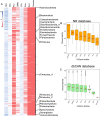Functional and phylogenetic analyses of camel rumen microbiota associated with different lignocellulosic substrates
- PMID: 35676509
- PMCID: PMC9177762
- DOI: 10.1038/s41522-022-00309-9
Functional and phylogenetic analyses of camel rumen microbiota associated with different lignocellulosic substrates
Abstract
Rumen microbiota facilitates nutrition through digestion of recalcitrant lignocellulosic substrates into energy-accessible nutrients and essential metabolites. Despite the high similarity in rumen microbiome structure, there might be distinct functional capabilities that enable different ruminant species to thrive on various lignocellulosic substrates as feed. Here, we applied genome-centric metagenomics to explore phylogenetic diversity, lignocellulose-degrading potential and fermentation metabolism of biofilm-forming microbiota colonizing 11 different plant substrates in the camel rumen. Diversity analysis revealed significant variations in the community of rumen microbiota colonizing different substrates in accordance with their varied physicochemical properties. Metagenome reconstruction recovered genome sequences of 590 bacterial isolates and one archaeal lineage belonging to 20 microbial phyla. A comparison to publicly available reference genomes and rumen metagenome-assembled genomes revealed that most isolates belonged to new species with no well-characterized representatives. We found that certain low abundant taxa, including members of Verrucomicrobiota, Planctomycetota and Fibrobacterota, possessed a disproportionately large number of carbohydrate active enzymes per Mb of genome, implying their high metabolic potential to contribute to the rumen function. In conclusion, we provided a detailed picture of the diversity and functional significance of rumen microbiota colonizing feeds of varying lignocellulose composition in the camel rumen. A detailed analysis of 591 metagenome-assembled genomes revealed a network of interconnected microbiota and highlighted the key roles of certain taxonomic clades in rumen function, including those with minimal genomes (e.g., Patescibacteria). The existence of a diverse array of gene clusters encoding for secondary metabolites unveiled the specific functions of these biomolecules in shaping community structure of rumen microbiota.
© 2022. The Author(s).
Conflict of interest statement
The authors declare no competing interests.
Figures





Similar articles
-
Metagenomic analysis reveals a dynamic microbiome with diversified adaptive functions to utilize high lignocellulosic forages in the cattle rumen.ISME J. 2021 Apr;15(4):1108-1120. doi: 10.1038/s41396-020-00837-2. Epub 2020 Dec 1. ISME J. 2021. PMID: 33262428 Free PMC article.
-
Molecular analysis of the bacterial microbiome in the forestomach fluid from the dromedary camel (Camelus dromedarius).Mol Biol Rep. 2013 Apr;40(4):3363-71. doi: 10.1007/s11033-012-2411-4. Epub 2013 Jan 1. Mol Biol Rep. 2013. PMID: 23277394
-
In-depth diversity analysis of the bacterial community resident in the camel rumen.Syst Appl Microbiol. 2015 Feb;38(1):67-76. doi: 10.1016/j.syapm.2014.09.004. Epub 2014 Oct 23. Syst Appl Microbiol. 2015. PMID: 25467553
-
Lignocellulose degradation by rumen bacterial communities: New insights from metagenome analyses.Environ Res. 2023 Jul 15;229:115925. doi: 10.1016/j.envres.2023.115925. Epub 2023 Apr 21. Environ Res. 2023. PMID: 37086884 Review.
-
Composition of bacterial and archaeal communities in the rumen of dromedary camel using cDNA-amplicon sequencing.Int Microbiol. 2020 May;23(2):137-148. doi: 10.1007/s10123-019-00093-1. Epub 2019 Aug 20. Int Microbiol. 2020. PMID: 31432356 Review.
Cited by
-
Metagenome-derived SusD-homologs affiliated with Bacteroidota bind to synthetic polymers.Appl Environ Microbiol. 2024 Jul 24;90(7):e0093324. doi: 10.1128/aem.00933-24. Epub 2024 Jul 2. Appl Environ Microbiol. 2024. PMID: 38953372 Free PMC article.
-
Profiling the dynamic adaptations of CAZyme-Producing microorganisms in the gastrointestinal tract of South African goats.Heliyon. 2024 Sep 6;10(17):e37508. doi: 10.1016/j.heliyon.2024.e37508. eCollection 2024 Sep 15. Heliyon. 2024. PMID: 39290285 Free PMC article.
-
Characterization of BrGH3A, a bovine rumen-derived glycoside hydrolase family 3 β-glucosidase with a permuted domain arrangement.PLoS One. 2024 Jul 9;19(7):e0305817. doi: 10.1371/journal.pone.0305817. eCollection 2024. PLoS One. 2024. PMID: 38980877 Free PMC article.
-
Age-related compositional and functional changes in the adult and breastfed buffalo rumen microbiome.Front Microbiol. 2024 May 30;15:1342804. doi: 10.3389/fmicb.2024.1342804. eCollection 2024. Front Microbiol. 2024. PMID: 38881655 Free PMC article.
-
Performance of 1-year-old camel calves fed a basal ration of alfalfa hay supplemented with different levels of concentrate.BMC Vet Res. 2025 Jan 27;21(1):36. doi: 10.1186/s12917-025-04485-6. BMC Vet Res. 2025. PMID: 39871270 Free PMC article.
References
Publication types
MeSH terms
Substances
LinkOut - more resources
Full Text Sources
Miscellaneous

